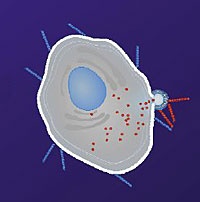Jun 30 2009
The European Research Council (ERC) has awarded chemist Dr Alexander Kros from University of Leiden a Starting Independent Researcher Grant of 1.4 million euro. He will be using the grant to study how molecules penetrate the natural barrier of a cell membrane. If his research is successful, it will in time bring about a revolution in how medicines are administered.
 The transport of molecules between and within cells is of vital importance in nature. But developers of medicines want to deliver the active ingredients of their drugs to the right location, namely within the cytoplasm of the cell.
The transport of molecules between and within cells is of vital importance in nature. But developers of medicines want to deliver the active ingredients of their drugs to the right location, namely within the cytoplasm of the cell.
The transport of molecules between and within cells is of vital importance in nature. But developers of medicines want to deliver the active ingredients of their drugs to the right location, namely within the cytoplasm of the cell.
Transport of molecules
There is a natural barrier in the form of cell membranes that separate the different compartments in the cell and the cell and its environment from one another. This barrier is impenetrable for many molecules.
Membrane fusion
Nature has found a solution for this problem, in the form of membrane fusion. The active ingredient to be transported is encapsulated in a small package, a so-called liposome. Following fusion between the membrane of the cell and the liposome, the contents of the liposome are introduced into the cell. This is an extremely rapid process, so rapid that the clean-up teams in the cell have no chance of cleaning up the infiltrator.
Membrane fusion
Nature has found a solution for this problem, in the form of membrane fusion. The active ingredient to be transported is encapsulated in a small package, a so-called liposome. Following fusion between the membrane of the cell and the liposome, the contents of the liposome are introduced into the cell. This is an extremely rapid process, so rapid that the clean-up teams in the cell have no chance of cleaning up the infiltrator.
Network of proteins
But how exactly this occurs is still uncertain. Kros: firstly it takes just milliseconds. Moreover, the SNARE proteins are regulated by a complicated network of other proteins, whose action can hardly be distinguished. An added complication is that these membrane proteins cannot easily be viewed in isolation using microscopy techniques because they are able to change structure and, consequently, function when they are isolated from the natural membrane.'
Imitate
As a result, there are conflicting theories about the exact mechanism of membrane fusion. And what does someone who was originally an organic chemist do if a mechanism cannot be studied in real life? He imitates it.
Model system
Kros: ‘Our PhD researcher Hana Robson Marsden has recently made a very small model of two peptides. This model system proved to effect membrane fusion very efficiently. The proof of principle has been provided. Of course, that does not mean to say that it takes place in nature in exactly the same way.'
Cell Observatory
By experimenting systematically with variations on this model system, Kros wants to effect two types of membrane fusion: liposomes with liposomes, and liposomes with a natural cell. And then he intends to open up the whole box of tricks of microscopy techniques to fathom out the mechanisms. 'It could not b more interdisciplinary,' in his opinion. To carry out his research, he has access to the Cell Observatory, where a great many techniques and the relevant expertise are gathered to image living cells.
Restaurants
‘The facilities in Leiden have become extremely good in recent years,' says Kros. 'And what's even more important: they are accessible. In any event, the technical facilities are better in the Netherlands than in UCLA or Caltech.’ But he then goes on to temper this by saying that the restaurants in these top American institutes are much more varied and better than here.
Everything that is water-soluble
It is high risk, high gain research, as Kros is aware. He cannot say whether it will be successful. However, if he manages to understand and control the process, a whole new way will open up of encapsulating medicines and introducing them into the cell. 'We are hoping for a generic method of including everything you can think of in such a package and emptying it as soon as it has entered the cell. It's very easy to make such a package. You can put anything that is water-soluble into it: DNA, messenger RNA, medicines - in theory the possibilities are limitless.
Protein chains with preferences
It was probably the simplicity of the idea that appealed to the ERC assessors, Kros believes. 'But the big question is, of course: if it works, can you ever use it to inject humans and animals with medicines? You will always have the problem of specificity: how can you make sure you get your molecule in exactly the right place in the body? But in time we might be able to develop auxiliary protein chains with specifric preferences.'
The ERC Starting Independent Researcher Grant is a subsidy of up to two million euro for five years for young researchers who obtained their doctorate between two and nine years ago and have demonstrated the potential to become leaders in their field.